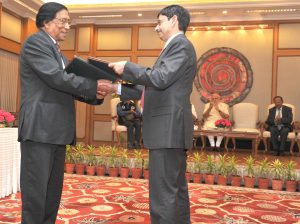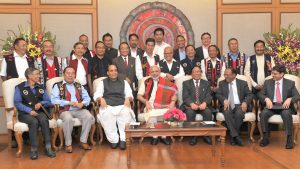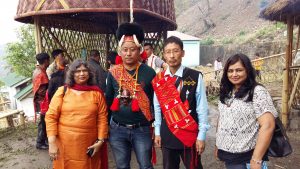
- Ceasefire with NSCN(R) extended for one year from today
By Sangeeta Saxena
Dimapur. 28 April, 2016. Many feel India has entered the last mile to end the 60-year Naga insurgency whereas some feel it is still a dream far fetched. On 3 August 2015 NSCN leader T Muivah signed a peace accord with the Government of India in presence of Prime Minister Narendra Modi, Home Minister Rajnath Singh, and NSA Ajit Doval. The ceasefire is in operation between Government of India and National Socialist Council of Nagaland (Reformation) (NSCN/R). The validity of ceasefire was further reviewed.
The Government of India decided to extend the ceasefire with NSCN/R for a further period of one year with effect from April 28, 2016. The agreement is signed by Satyendra Garg, Joint Secretary, Ministry of Home Affairs on behalf of Government of India and Imlongnukshi Chang and Kavishe Sumi on behalf of NSCN/R.
It was NSCN(IM) and NSCN(K) and suddenly came on the scene NSCN(R). On 6 April 2015 a new faction NSCN (Reformation) was formed. Y. Wangtin Konyak and P. Tikhak officially announced the formation of a new Naga political group going by the name ‘National Socialist Council of Nagaland (Reformation)’ or NSCN (R). The decision came after Wangtin Konyak, a senior minister (Kilonser) and personal secretary to Khaplang and Tikhak, the spokesperson of the outfit were expelled by Khaplang after misunderstanding arose over the recent abrogation of ceasefire with the Government of India.
If we go back into history, the undivided NSCN, led by SS (Shangwang Shangyung) Khaplang, Isak Chisu Swu and Thuingaleng Muivah was set up on January 31 1980 to fight for “securing the independence of the contiguous Naga-inhabited regions of India and Myanmar.” The Indian and Myanmar Naga territories were thus brought under a single leadership for the first time.
The parallel Government of the People’s Republic of Nagaland (GPRN) along with an armed wing were also set up. However, in 1988, when Muivah unilaterally raised the issue of talks with India without informing Khaplang or other important Naga groups, the Khaplang group rebelled and was forced to set up the rival NSCN-K to continue the uncompromising fight for independence and sovereignty.
In 1997, Isak and Muivah (NSCN-IM) opted for ceasefire and negotiations with India within the four corners of the Indian Constitution. Though the Naga movement was indivisible between India and Myanmar with the Nagas of both countries facing similar problems in contiguous areas, Khaplang was sought to be excluded from the negotiations under pressure from the NSCN-IM on the argument was that Isak and Muivah were Indian Nagas while Khaplang was a Myanmar national.
On March 27 2015, Khaplang scrapped the tactical ceasefire agreement that he had earlier had with India and resumed violent actions in India’s northeast. He also brought into existence the new political instrument of struggle, the UNLFWSEA, whose militants carried out the devastating June 4 attack on the Indian army convoy in the Chandel district of Manipur.

Little is known about the details of the Centre’s “accord” with the National Socialist Council of Nagalim – Isak-Muivah (NSCN-IM), but after nearly 18 years of negotiations under ceasefire, it is a silver lining in the cloud. Six decades after the first armed clashes broke out between Naga rebel groups and Indian security forces, the Government of India has signed a framework agreement with the largest insurgent group from the north-eastern state – the National Socialist Council of Nagaland (Isak-Muivah).
But the quest for a political settlement to the Naga issue goes back all the way to 1947 when Naga National Council leader A.Z. Phizo declared the independence of the Naga region one day before India itself became independent on August 15 that year. After several rounds of discussions with Jawaharlal Nehru, India’s first Prime Minister, Phizo took up arms.
“Today’s agreement is a shining example of what we can achieve when we deal with each other in a spirit of equality and respect, trust and confidence; when we seek to understand concerns and try to address aspirations; when we leave the path of dispute and take the high road of dialogue. It is a lesson and an inspiration in our troubled world,” the Prime Minister said at the signing ceremony. But the peace accord needs to be explained to the common Naga. Unfortunately the elaborations of the accord have not even been made privy to the naga watchers in Delhi and will this secrecy help in resolving the crisis? The message has to percolate to the last man and only then will the people understand and hope to find life in peace. The intention is good but the silence on the accord’s details may not be helpful, is the common Naga’s fear.
And eight months since, lets ask ourselves a question-are we actually near a solution. All seems quite on the Naga front but is it a lull before the storm?



























































































































